AI vs. Automation: What’s the Difference and When to Use Each?
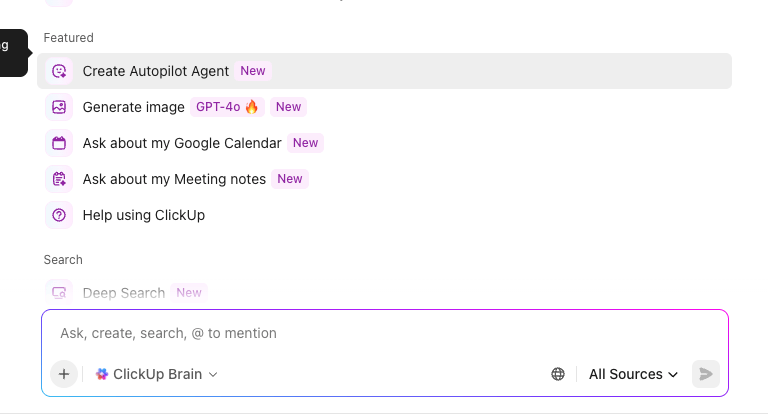
Sorry, there were no results found for “”
Sorry, there were no results found for “”
Sorry, there were no results found for “”

Often used interchangeably, AI and automation are two distinct forces reshaping industries.
Although they share some overlap, their functions differ significantly.
Automation is built to perform repetitive tasks based on predefined rules, reducing human effort in routine workflows.
In contrast, artificial intelligence focuses on complex tasks that require decision-making and the ability to mimic human intelligence. AI supports users by analyzing complex data and offering insights that drive smarter business processes.
Let’s break down the AI vs. automation debate in more detail and see how each can help perform tasks more efficiently in the business world. We’ll also touch on how you can integrate AI with automation.
You’re managing a growing team, and every week you’re stuck manually assigning tasks, checking who’s overloaded, reminding people about deadlines, and emailing status updates to stakeholders.
It’s time-consuming and prone to human error.
This is where automation steps in. With automation tools taking care of repetitive tasks, you can streamline business processes like task assignment, scheduling, and reporting without constant human intervention.
At its core, automation relies on predefined rules to manage workflows efficiently, allowing teams to focus on complex tasks that require human judgment rather than relying on automated processes.
📖 Also Read: Best 13 AI Agents for Content Creation to Explore
According to Gartner, 80% of executives believe automation can apply to any business decision.
From business operations to customer-facing workflows, here are some ways you can use automation tools to reduce effort and save time:
| Use case | What automation does | Why it matters |
|---|---|---|
| 📊 Data entry | Pulls structured & unstructured data into central systems | Reduces manual errors and lets teams focus on analysis |
| 📄 Invoice processing | Routes invoices, validates amounts, and triggers payments using rules | Ensures compliance and speeds up payment cycles |
| 👩💻 Employee onboarding | Automates account setup, tool access, and training workflows | Frees IT/HR teams and delivers a smooth onboarding experience |
| 🎧 Customer service management | Triages tickets, handles FAQs, and escalates complex issues | Cuts response time and empowers human agents for high-value tasks |
| 📧 Email organization | Categorizes, follows up, and archives emails automatically | Keeps inboxes clean and helps teams stay on top of communication |
👋🏾 So what’s it like to put your work on autopilot with some really smart automations? Here’s an example.
💡 Pro Tip: Struggling to stay on top of tasks and updates as a project manager? How to Optimize Project Management with Automation shows you how to eliminate busywork and reclaim your focus using simple, smart automation tactics that actually scale.
Let’s say you are a product manager overseeing multiple sprint cycles but struggling to identify which features are likely to cause delays.
Instead of manually reviewing every ticket or relying on team hunches, an AI tool can scan past sprint data, detect patterns of bottlenecks, and flag high-risk user stories for you.
This is how artificial intelligence works: it enables machines to mimic human cognitive functions, such as learning from complex data, recognizing risks, and supporting decision-making.
Unlike traditional automation tools, which follow predefined rules, AI systems adapt dynamically using machine learning and natural language processing.
🧠 Extra Tips: In the blog How to Use AI to Automate Tasks, you’ll learn how to put that belief into action by using AI technologies to eliminate repetitive work and boost team productivity.
AI is now embedded in the core of how modern businesses operate.
It can summarize a chat thread, help you make data-driven decisions, and even diagnose the onset of cancer, thanks to its versatile use cases.
So, how do you leverage such a versatile tool to its maximum potential? Here are some of the more popular use cases:
| Use case | How it works | Why it matters |
|---|---|---|
| 💬 Virtual assistants & chatbots | Uses NLP to understand user queries and deliver instant, 24/7 support | Reduces wait times and improves customer satisfaction |
| 🕵️ Real-time fraud detection | Analyzes large datasets to identify suspicious patterns | Helps prevent fraud and ensures regulatory compliance |
| 🏥 Healthcare diagnostics | Reviews scans and patient histories to assist in early detection and automation | Enhances decision-making and reduces administrative workload |
| 🚗 Autonomous vehicles | Uses AI (CV, ML, sensors) to navigate, avoid obstacles, and optimize routes | Improves safety, efficiency, and real-time decision-making |
| 🛒 Personalized e-commerce | Recommends products based on user behavior and preferences | Boosts engagement and drives conversions through tailored experiences |
💡 Pro Tip: Drowning in follow-ups, status updates, or endless data entry? 15 Task Automation Software highlights top tools that help you automate the grunt work, so your team can finally focus on what moves the needle.
📮 ClickUp Insight: 88% of our survey respondents use AI for their personal tasks, yet over 50% shy away from using it at work.
The three main barriers? Lack of seamless integration, knowledge gaps, or security concerns.
But what if AI is built into your workspace and is already secure?
ClickUp Brain, ClickUp’s built-in AI assistant, makes this a reality. It understands prompts in plain language, solving all three AI adoption concerns while connecting your chat, tasks, docs, and knowledge across the workspace. Find answers, automate busywork, and get insights all with just one tool!
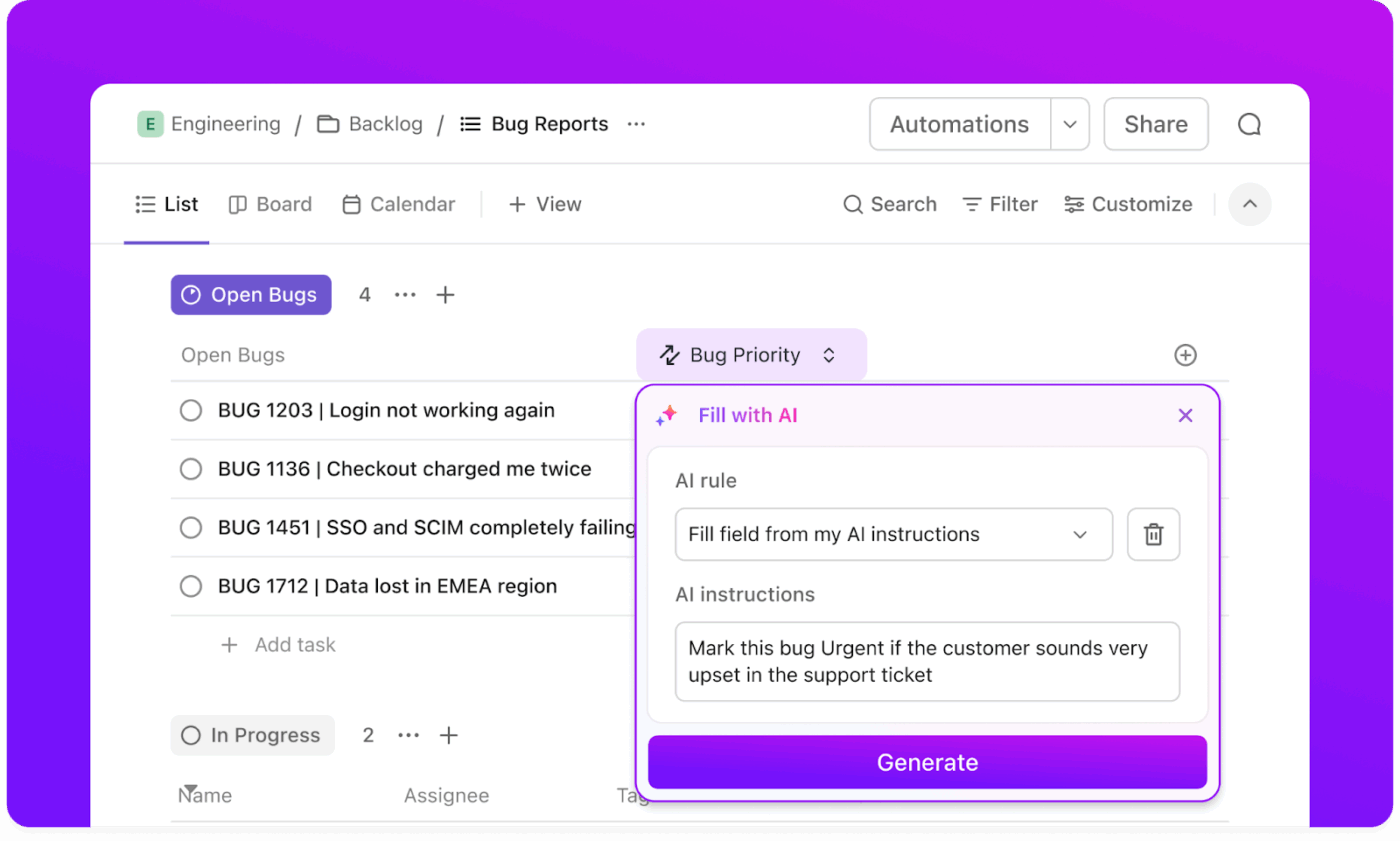
It’s quite safe to say that none of us are strangers to AI or automation.
73% of companies increased their automation investments last year, and nearly 40% reported cost reductions of at least 25%.
On the other hand, only 42% of large enterprises have moved beyond experimentation to actively deploy AI in their operations.
Automation is clearly charging ahead in terms of adoption, but AI has the potential to bring far more benefits.
For a better understanding of how both deliver on their promises, here’s a quick comparison to clarify the core differences between AI and automation:
| Aspect | Automation | Artificial Intelligence (AI) |
| ➡️ Definition | Uses technology to perform repetitive tasks based on predefined rules | Simulates human cognitive functions like learning, reasoning, and decision-making |
| ➡️ Task type | Structured, rule-based, routine | Unstructured, dynamic, complex tasks |
| ➡️ Learning ability | Does not learn; must be manually updated | Learns from data, improves over time via machine learning |
| ➡️ Decision making | Cannot make decisions without human input | Capable of independent decision making based on real-time analysis |
| ➡️ Human intervention | Requires frequent human oversight | Operates with minimal to no human intervention |
| ➡️ Examples | Data entry, invoice processing, scheduling | Capable of independent decision-making based on real-time analysis |
| ➡️ Technologies | Macros, scripts, automation tools, workflow engines | AI agents, NLP engines, and intelligent automation platforms |
| ➡️ Outcome | Improves operational efficiency, reduces human error | Adds intelligence to systems, enables adaptation, and process automation |
💟 Bonus: Want to bring the best of AI and automation with just one app? Brain MAX is your all-in-one AI automation platform, letting you streamline and execute workflows from a single desktop app using simple voice commands.
With deep integration across your emails, calendars, documents, CRM, and project management tools, Brain MAX continuously syncs and understands your real-time work context—so every automation and AI suggestion is tailored to what you actually need. Just speak naturally to trigger automations, create tasks, update records, or launch complex, multi-step workflows that span multiple apps.
Brain MAX gives you access to multiple leading AI models (like GPT, Claude, and Gemini) for advanced reasoning, content generation, and data analysis, all from one interface. You can automatically assign tasks, set reminders, update statuses, and retrieve files or analytics instantly, with every action respecting your workspace permissions and privacy.
📖 Also Read: Best AI Automation Tools for Productivity
While there are differences, AI and automation work best as a team: one thinks, the other acts.
Here’s how the two technologies complement each other in real-world use cases:
✅ AI analyzes IT tickets to understand context, urgency, and content using natural language processing → automation then routes them to the right agent or resolves routine requests like password resets
✅ AI detects anomalies in financial data using predictive analytics → automation triggers alerts, freezes suspicious transactions, or initiates a manual review
✅ AI understands user queries in self-service chatbots and determines intent. → Automation carries out actions like updating records, resetting access, or generating documents
✅ AI monitors project data and forecasts potential delays or resource conflicts → automation tools adjust task schedules or notify team leads in real time
✅ AI identifies skill gaps or performance trends in employee data → automation initiates onboarding, training modules, or reassignments
💡 Pro Tip: Struggling to focus with constant pings and packed calendars? Ways to Be More Productive at Work shares 10 simple strategies to help you cut distractions, reclaim your time, and actually get things done.
These companies are a testament to the real magic of AI and automation working in collaboration.
👉🏽 Changes introduced by automation: At the Memphis World Hub, FedEx installed six-sided barcode scanners, auto-dimensioning systems, and 11 miles of conveyors to facilitate sortation. These automation tools ensure faster and more reliable package routing
👉🏽 Changes introduced by AI: FedEx uses predictive analytics to anticipate delays, optimize routes, and manage peak loads intelligently. AI also enhances customer experience by providing real-time delivery forecasts
✅ Impact: Reduced sort times, improved operational reliability, and enhanced capacity to handle spikes in package volume with minimal human effort
👀 Fun Fact: Henry Ford’s assembly line was one of the earliest industrial automation breakthroughs. In 1913, Ford used conveyor belts to move vehicles between stations, cutting the time to produce a single Model T from over 12 hours to just 90 minutes!
👉🏽 Changes introduced by automation: Heineken implemented PLC-based automation systems across bottling, labeling, and warehouse workflows. This enabled consistent production with minimal human intervention
👉🏽 Changes introduced by AI: AI-driven digital twins simulate energy use and optimize process efficiency. Machine vision monitors quality control in real-time, improving output while reducing waste
✅ Impact: Achieved significant energy savings, reduced carbon emissions, and improved operational consistency across global facilities
While automation and AI can significantly reduce human effort, both come with limitations that business leaders must plan for, despite the potential for cost savings.
Automation works best in structured environments. However, when faced with unpredictable situations or the need for flexible reasoning, automation begins to reveal its limitations.
Automation follows a set of predefined rules and can only execute what it’s programmed to do. Automation tools can’t weigh context or make judgment calls if something unexpected happens without human intervention.
A rule-based email routing system may forward support tickets based on specific keywords. However, if a customer writes in natural language or incorrectly labels the issue, the system may misroute or ignore the ticket. At the end of the day, automation tools don’t adapt on their own.
Automating payroll processing, for instance, works wonderfully when all timesheets are submitted in the same format. If one team sends hours in a PDF and another in a spreadsheet, the automation breaks. It lacks the flexibility to interpret unstructured data in the same way AI might, using natural language processing or computer vision.
AI brings adaptability…but at a cost.
It requires data analysis, expertise, and trust in outputs that aren’t always easy to verify.
Implementing AI-powered automation is expensive. A mid-sized company seeking to automate customer support with AI chatbots may need to invest in custom NLP training, data labeling, infrastructure, and ongoing model updates, making it a long-term endeavor rather than a quick win.
🧠 Extra Tips: In A Guide to Using AI Workflow Automation for Maximum Productivity, you’ll discover how combining AI and automation can cut manual effort, reduce costs, and keep your team focused on high-impact work.
In risk analysis, an AI model may deny a loan or flag a transaction as potentially fraudulent based on learned patterns. But when asked “why,” it often can’t offer a clear reason, making it a black box decision. This lack of transparency makes it difficult for teams in finance, healthcare, or human resources to justify decisions.
👀 Fun Fact: One of the earliest known examples of automation dates back over 3,500 years to ancient Egypt, where engineers developed the world’s first water clocks. These devices measured time by regulating the flow of water between containers.
Let’s say a company wants to use AI to predict equipment failure. The model can’t learn or make accurate predictions without years of historical sensor data. Unlike automation technologies, AI needs large, clean, and relevant datasets to learn from, which can be difficult to collect or prepare.
If you’re tired of doing the same things over and over and answering the same questions endlessly, let ClickUp Brain automate up to 70% of your tasks with this quick guide:
Slow and siloed systems kill efficiency.
Many teams still rely on fragmented tools to manage workflows, using one platform for project tracking, another for communication, and yet another for AI content creation.
This fragmented setup, also known as Work Sprawl, leads to redundant tasks, disjointed data, and workflows that collapse when flexibility is required.
Worse, it reinforces the very limitations we highlighted earlier: automation without context and AI without execution.
ClickUp solves this by integrating AI collaboration tools and automation into a single platform where tasks, docs, people, and goals are connected through intelligent, rule-based workflows.

ClickUp Automations handles routine, repetitive tasks, such as assigning owners, updating statuses, sending emails, or initiating handoff workflows, without requiring human oversight.
With prebuilt templates and dynamic conditions, you can automate nearly every part of your business processes, from onboarding to reporting.
For instance, instead of manually assigning tasks every time a form is submitted, ClickUp Automations can instantly create the task, set a due date, assign it based on load, and notify the assignee. All you need to do is toggle on the settings and define conditions.👇🏼
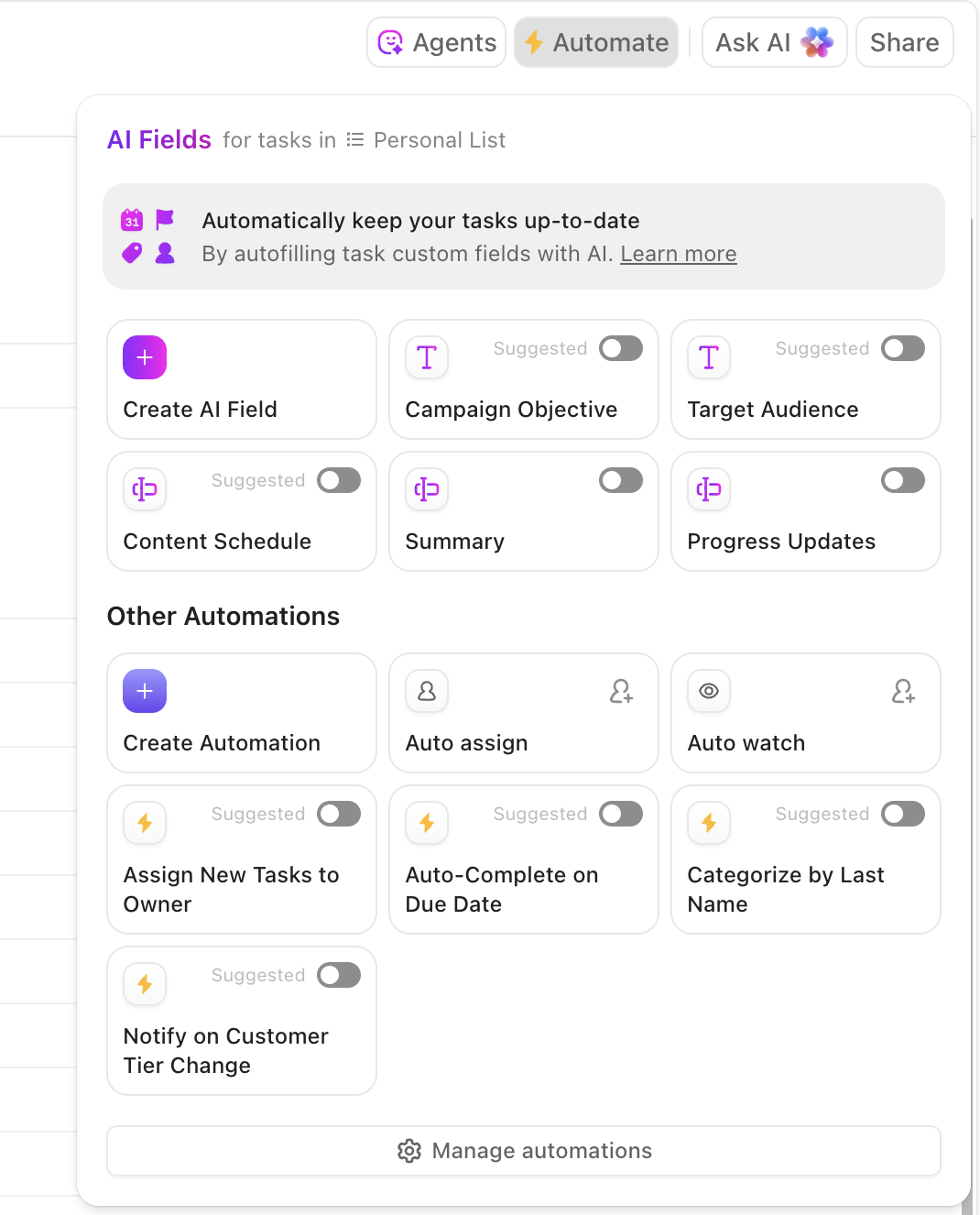
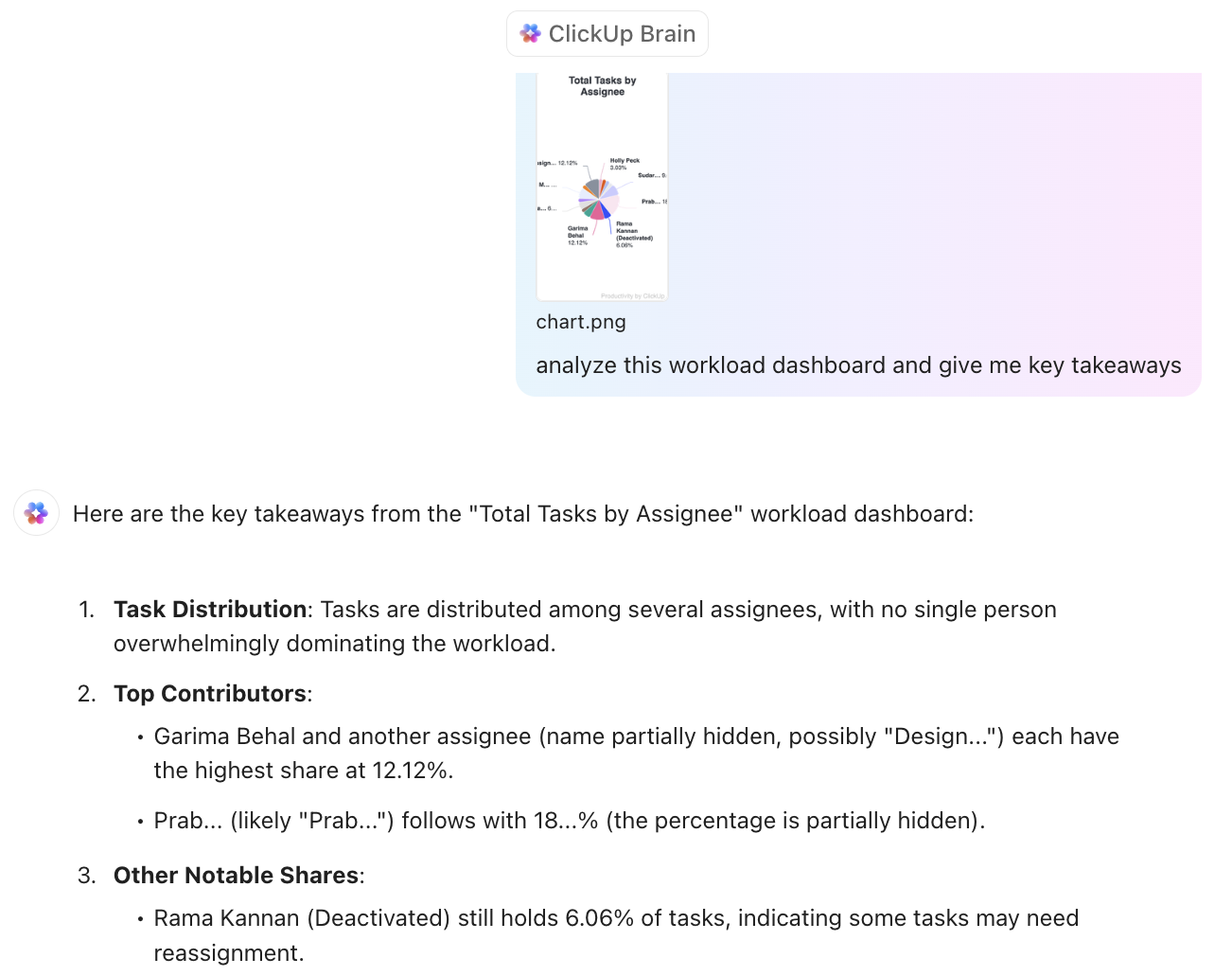
ClickUp Brain brings artificial intelligence into everyday workflows with contextual summaries, instant answers, and auto-generated documentation.
We’re talking about writing SOPs, summarizing long threads, or creating task updates. ClickUp AI removes the manual effort from cognitive tasks that require new data context and clarity every step of the way.
Going one step further, it can even help you create an agentic workflow step by step!

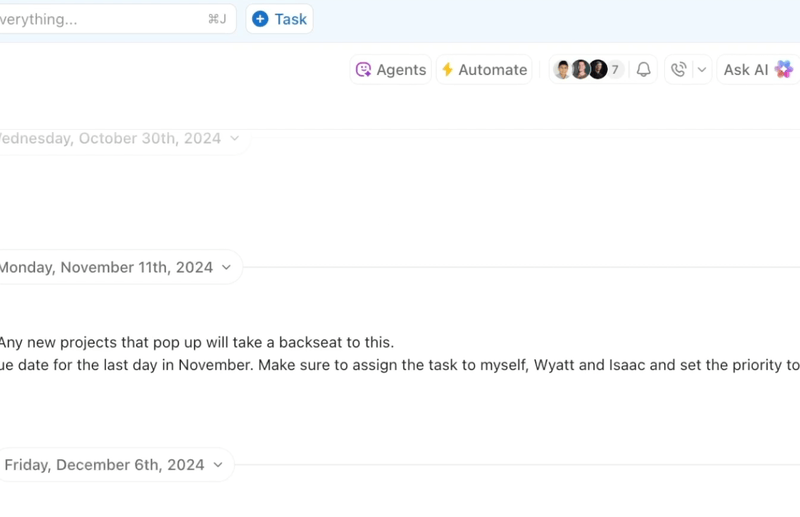
The real power lies in combining both: AI handles interpretation, and automation takes action.
With ClickUp’s AI Automation Builder, you can design agentic workflows where one trigger launches both intelligent insight and mechanical execution without jumping between tools!
Take a look at the Autonomous Answers Agent, for instance. It can understand the questions posted in a channel and pull up answers from the mapped resources (specified via the automation builder). Meaning you never have to spend time answering repetitive questions again.
You also have agents to send weekly or daily updates, triage tickets, and more!
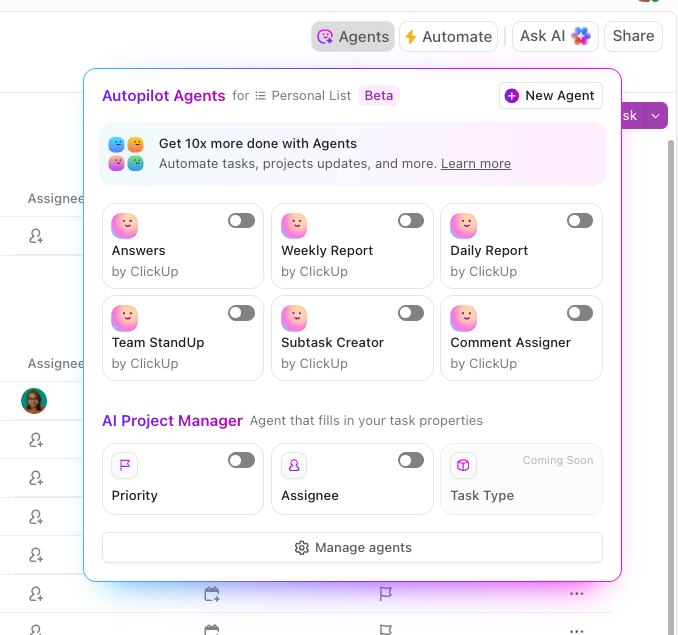
📌 Example: A meeting ends, and someone drops rough notes into a task →
As a result, in this setup:
Bonus: Need specific support in ClickUp? Certified AI Agents are ready to automate and streamline your workflows—whether it’s campaign management, project execution, client service delivery, onboarding, bug resolution, or strategic initiatives. These prebuilt and customizable agents handle repetitive tasks, provide intelligent assistance, and can be tailored to your unique needs, helping your team save time and focus on what matters most.
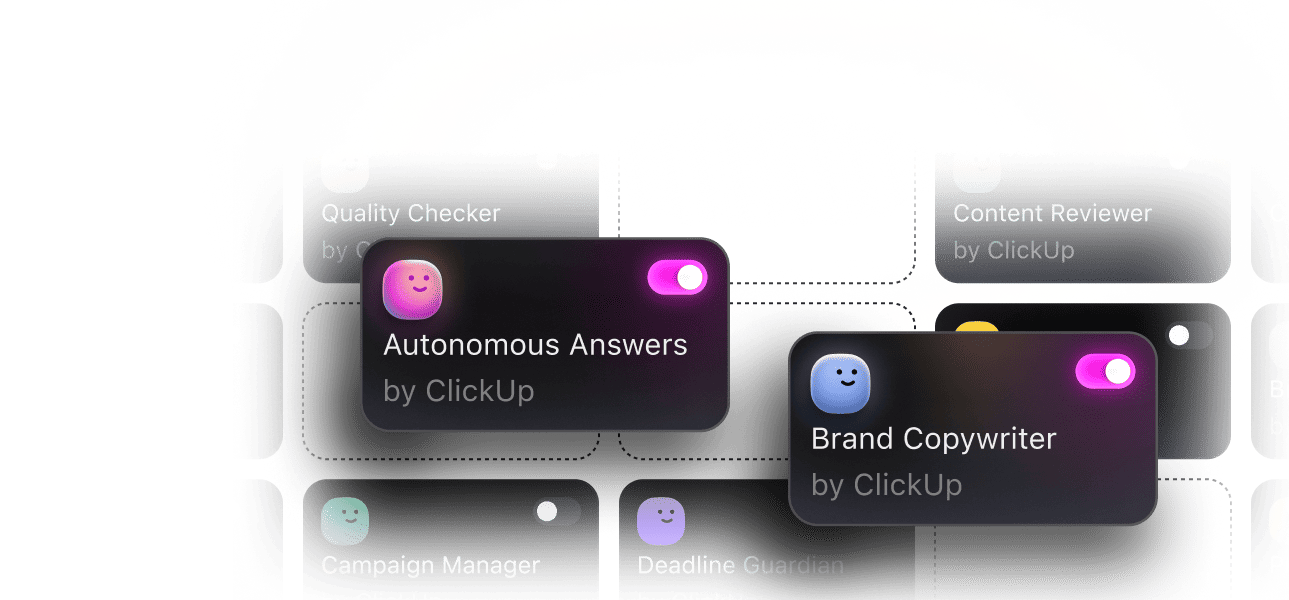
You hired your employees for a reason: strategy, creativity, and growth.
These primary jobs get lost amidst secondary tasks of organizing and analyzing data.
The true secret to increasing operational efficiency is combining AI and automation to leverage generative AI, allowing your teams to focus on their core tasks.
ClickUp combines both AI-powered intelligence and robust automation tools into a single, connected workspace. It helps you think smarter within digital systems, move faster, and operate seamlessly. As proof, Sid Babla of the Dartmouth College Student Wellness Center notes:
ClickUp reduces the need to have multiple software for managing a project by providing features like comments and auto-delivering notifications when users are tagged. Further, it integrates with tools like Miro and GDrive, eliminating the need to replicate tasks/content in those systems.
Are you ready to simplify your workflows using AI and automation, avoiding the complications of multiple platforms? Sign up for ClickUp now!
Traditional automation uses computational systems and automated systems to handle routine tasks and repetitive processes based on set rules and human input. AI, on the other hand, enables machines to learn from new data, understand natural language, and adapt to changing situations, often requiring human oversight for complex decisions. While automation improves productivity by reducing operational costs, AI capabilities drive digital transformation by allowing systems to perform tasks that previously required human beings.
AI can be considered an advanced form of automation. While traditional automation focuses on repetitive processes and routine tasks, AI involves enabling machines to analyze new data, understand natural language, and make decisions with minimal human input. AI-powered automated systems go beyond simple rule-based actions, offering greater flexibility and intelligence.
Automation refers to computational systems designed to perform routine tasks and repetitive processes with minimal human input. AI agents, however, are automated systems with advanced AI capabilities—they can understand natural language, learn from new data, and make decisions, often requiring human oversight for complex scenarios. AI agents represent a step forward in digital transformation, enabling machines to handle tasks that go beyond traditional automation.
Automation refers to computational systems designed to perform routine tasks and repetitive processes with minimal human input. AI agents, however, are automated systems with advanced AI capabilities—they can understand natural language, learn from new data, and make decisions, often requiring human oversight for complex scenarios. AI agents represent a step forward in digital transformation, enabling machines to handle tasks that go beyond traditional automation.
© 2025 ClickUp